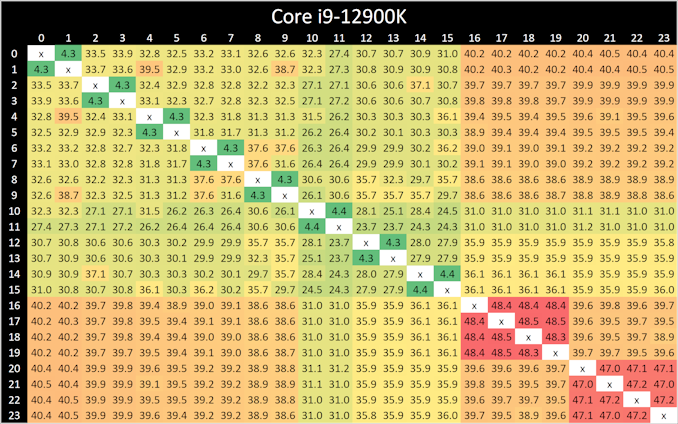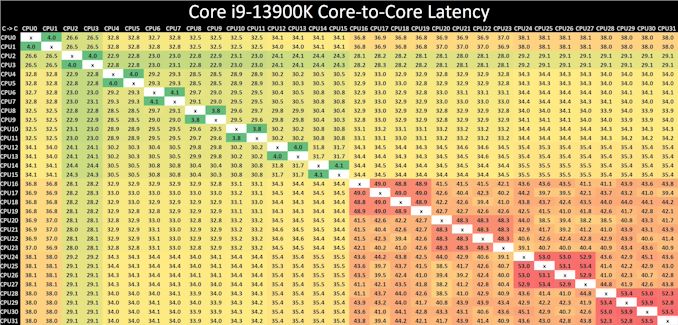Intel Core i9-13900K and i5-13600K Review: Raptor Lake Brings More Bite
by Gavin Bonshor on October 20, 2022 9:00 AM ESTCore-to-Core Latency
As the core count of modern CPUs is growing, we are reaching a time when the time to access each core from a different core is no longer a constant. Even before the advent of heterogeneous SoC designs, processors built on large rings or meshes can have different latencies to access the nearest core compared to the furthest core. This rings true especially in multi-socket server environments.
But modern CPUs, even desktop and consumer CPUs, can have variable access latency to get to another core. For example, in the first generation Threadripper CPUs, we had four chips on the package, each with 8 threads, and each with a different core-to-core latency depending on if it was on-die or off-die. This gets more complex with products like Lakefield, which has two different communication buses depending on which core is talking to which.
If you are a regular reader of AnandTech’s CPU reviews, you will recognize our Core-to-Core latency test. It’s a great way to show exactly how groups of cores are laid out on the silicon. This is a custom in-house test, and we know there are competing tests out there, but we feel ours is the most accurate to how quick an access between two cores can happen.

Looking at core-to-core latencies going from Alder Lake (12th Gen) to Raptor Lake (13th Gen), things look quite similar on the surface. The P-cores are listed within Windows 11 from cores 0 to 15, and in comparison to Alder Lake, latencies are much the same as what we saw when we reviewed the Core i9-12900K last year. The same comments apply here as with the Core i9-12900K, as we again see more of a bi-directional cache coherence.
Latencies between each Raptor Cove core have actually improved when compared to the Golden Cove cores on Alder Lake from 4.3/4.4 ns, down to 3.8/4.1 ns per each L1 access point.
The biggest difference is the doubling of the E-cores (Gracemont) on the Core i9-13900K, which as a consequence, adds more paths and crossovers. These paths do come with a harsher latency penalty than we saw with the Core i9-12900K, with latencies around the E-cores ranging from 48 to 54 ns within four core jumps between them; this is actually slower than it was on Alder Lake.
One possible reason for the negative latency is the 200 MHz reduction in base frequency on the Gracemont cores on Raptor Lake when compared with Alder Lake. When each E-core (Gracemont) core is communicating with each other, they travel through the L2 cache clusters via the L3 cache ring and back again, which does seem quite an inefficient way to go.











169 Comments
View All Comments
FinTechno - Saturday, October 22, 2022 - link
I don't know what is it but openbenchmarking.org gives geometric mean of all tests +20% for 7950X. In many tests 7950X kills 13900K by huge margin. Please see https://openbenchmarking.org/vs/Processor/AMD%20Ry... ReplyCT007 - Sunday, October 23, 2022 - link
So many apps that nobody uses. . . -_- ReplyCinzzano - Saturday, October 22, 2022 - link
Why would undercut all of the processors with such a piss poor RAM configuration... this is just ridiculous to pair 13th Gen Zen4 and even 12th Gen with such a slow memory and those timings...The whole review and testing are invalid. Reply
James5mith - Saturday, October 22, 2022 - link
"Whereas Alder Lake officially topped out at DDR5-4800, Alder Lake can run at DDR5-5600, helping to feed the beast a bit more with higher memory clockspeeds."Guessing the second mention should be Raptor Lake. Reply
Hrel - Sunday, October 23, 2022 - link
I really don't want any CPU over 65W Replynandnandnand - Sunday, October 23, 2022 - link
You can limit TDPs yourself. ReplyContrabondo - Friday, December 16, 2022 - link
To get performance lower than zen 3 5950x?FYI 5950x when properly tuned draws about 70-75W in Cinebench R23 at 3200MHz Reply
Archer_Legend - Sunday, October 23, 2022 - link
Nice review, however I have to say that this site has lost itself after the departure of Andrei and Ian.The deep dives on mobile processors for smartphones were very important as you were the only ones to do those and it is a real shame not to have Spec data and a detailed comparison of the A14, A15, Exynos 2100, Exynos 2200, Snapdragon 888, Snapdragon 8 gen 1, Snapdragon 8 plus gen 1, Dimensity 9000 and Dimensity 9000+.
I hope that you find and you are actively looking for a new editor for those pieces of content and that onceyou find one you push out deep dives on those SOCs even if they will not be the latest and greatest because it will complete the amazing database of reviews which stopped with 865 and those reviews where real gold! Reply
Gothmoth - Sunday, October 23, 2022 - link
good that intel is able to compete for now. but i go for the AM5 plattform.support until 2025 at least and the X 3D versions will blow intel out of the water.
i am not buying an already EOL plattform for a bit more performance. Reply
TheinsanegamerN - Monday, October 24, 2022 - link
Why not stop buying CPUs every year? It's a waste of money. Reply